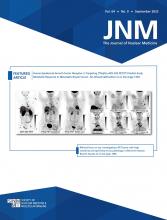The American Board of Nuclear Medicine (ABNM) has certified 6,031 physicians in nuclear medicine (NM) from 1972 to 2022, of whom 3,733 are still active, meaning they are not retired or deceased and have maintained their ABNM certification (Fig. 1). This number has not changed significantly since 2015, indicating that the workforce is stable despite the decrease in the number of Accreditation Council for Graduate Medical Education (ACGME)–accredited NM programs from 43 to 36 during the same period.
Active, retired, and deceased ABNM diplomates.
There has been a marked decrease in the total number of residents in ACGME-accredited NM programs since 2009, when the number was 166 (Fig. 2). The decrease initially was due to an increase in the length of training from 2 to 3 y required by the ACGME in 2007, but this change could not explain the continuing decline until 2016, when the number reached a nadir of 74 before stabilizing. There are currently a total of 80 NM residents, which does not account for additional trainees in other pathways.
Number of NM programs and trainees.
There was also a decrease in the number of physicians certified by the ABNM each year, but the decrease started later, and the percentage decrease was smaller (Fig. 3). More recently, there has been a significant increase in the number of diplomates certified by the ABNM without a significant change in the total number of NM residents. The reason is an increasing number of physicians in dual NM and diagnostic radiology (DR) training pathways that shorten NM training from 3 y to a minimum of 16 mo, as well as an increasing number of physicians who are designated by their training institutions as DR residents or NM fellows in non–ACGME-accredited positions during their NM training. For example, 20% of ABNM-certified physicians from 2018 to 2022 completed 16 mo of NM training during 4 y of DR training, equal to the percentage of physicians who completed 3 y of NM training.
Number of ACGME NM residents per academic year vs. ABNM diplomates certified each year.
Diagnostic radiologists who are also certified by the ABNM have always been a majority of physicians practicing NM. The average percentage over the past 20 y has been 54%, but the percentage over the past 5 y has increased to 70% (Fig. 4). The training pathways of candidates for the 2022 ABNM certification are shown in Figure 5. Twenty-eight percent of candidates completed 3 y of NM training, with an additional 7% having NM training outside the United States and Canada. Sixty-five percent of candidates had DR training, including 27% with 4 y of DR training plus an additional 1 y of NM or nuclear radiology training, and 26% with 16 mo of NM training during 4 y of DR training. Candidates with DR training had a pass rate of 96% on the 2022 ABNM certification examination, indicating a high degree of competence.
Annual number and average percentage (20 y/last 5 y) of ABNM diplomates certified by other American Board of Medical Specialties member boards. ABR = American Board of Radiology.
Training pathways of candidates for 2022 ABNM certification examination. ABR alt = American Board of Radiology alternative.
The average percentage of NM physicians certified in medical specialties other than radiology has decreased from 10% to 5% over the past 20 y. The ABNM and the American Board of Internal Medicine have a 4-y combined training pathway leading to certification in both specialties, but few physicians have used this pathway. In the future, there may be increased interest in this pathway because of the importance of NM in oncology, particularly theranostics.
There are opportunities and challenges in training the future NM workforce. Presently, there is an overreliance on international medical graduates. In 2011, international medical graduates accounted for 59% of NM residents. In 2021, that percentage increased to 82%. Thirty-three percent of the 36 ACGME-accredited NM programs did not have any medical students from their affiliated universities matriculate into any NM program in the United States, on the basis of candidates taking the ABNM certification examination in the past 5 y (2018–2022). Another 36% had only 1 student matriculate into a NM program during the same period. Recruiting medical students at the universities that have ACGME-accredited NM programs is an important opportunity.
The impact of dual training in NM and DR on the number of physicians who choose an academic career and do NM research is unknown. On the basis of self-reported information in 2020, 43% of ABNM physicians answered that they were in academic practice, 46% answered that they were in private practice, and 11% answered “other” (1). The percentage of NM physicians in academic practice seems robust, but the ABNM does not have any information about the amount of research being performed. The ACGME and the ABNM currently allow up to 6 mo of elective or research time during 3 y of training. There is an opportunity to engage the ACGME and other stakeholders to develop models that promote research during training and encourage residents to pursue academic careers (2).
Change is inevitable. NM will continue to evolve as a specialty. The ABNM will work with all stakeholders to meet the challenges and take advantage of the opportunities to ensure a bright future.
Footnotes
Published online Aug. 10, 2023.
- © 2023 by the Society of Nuclear Medicine and Molecular Imaging.
REFERENCES
- Received for publication May 4, 2023.
- Revision received July 17, 2023.












